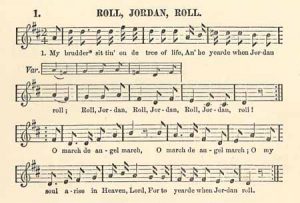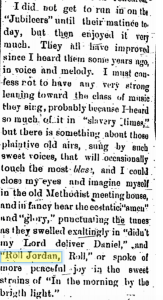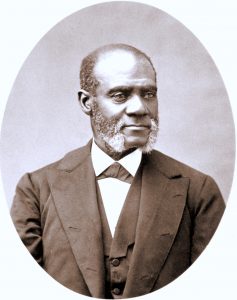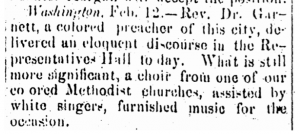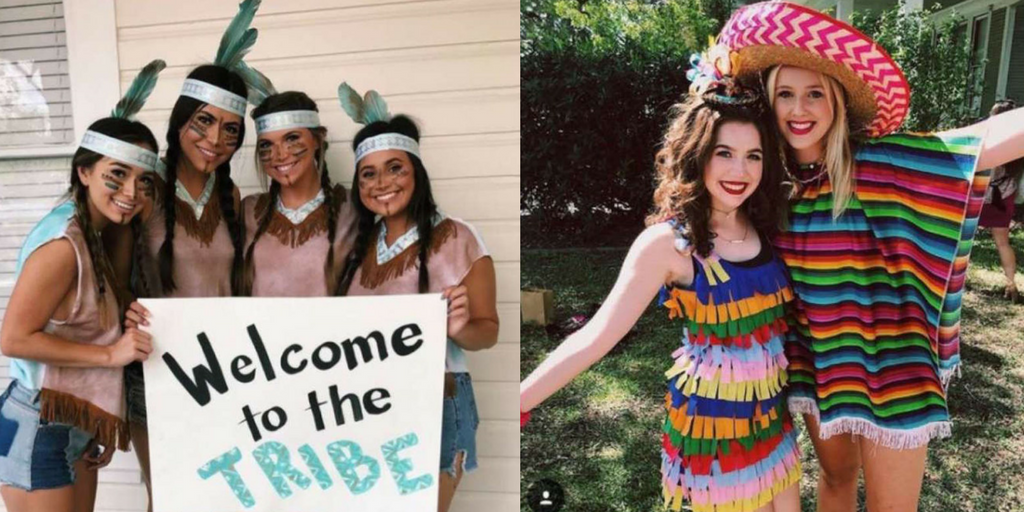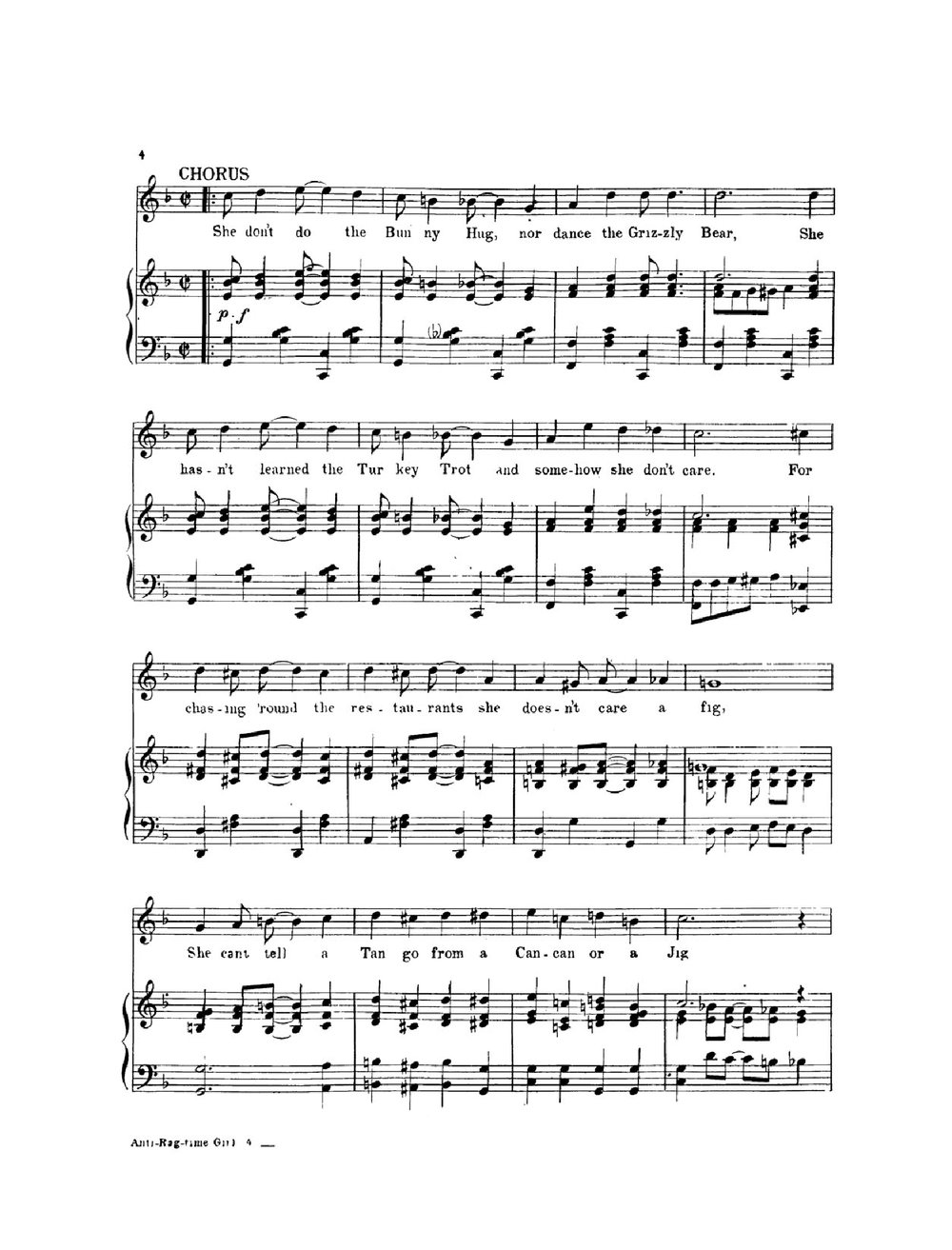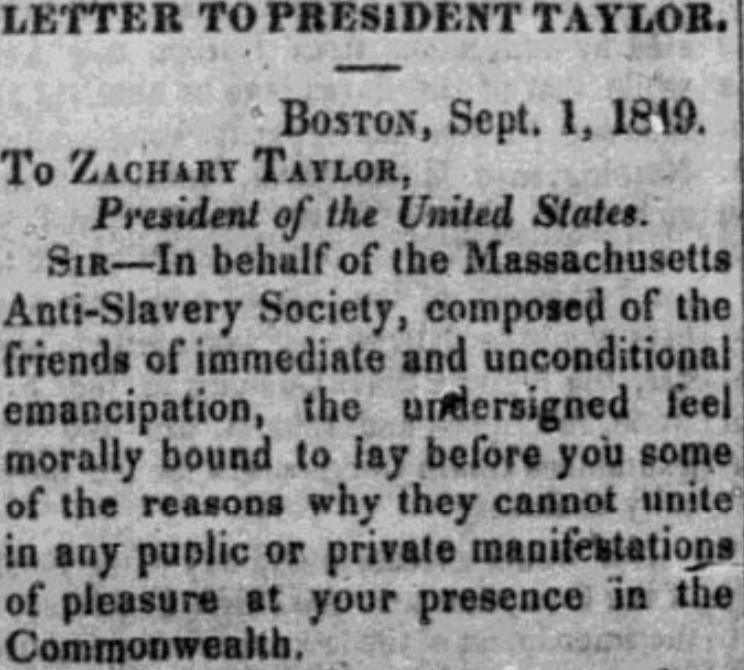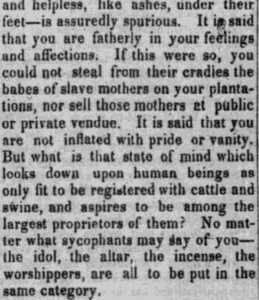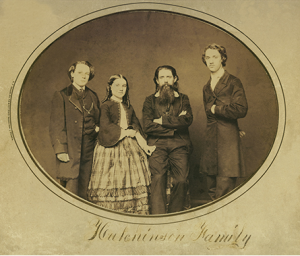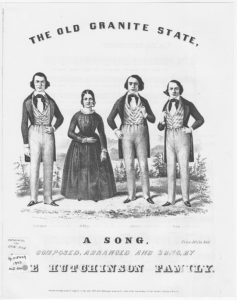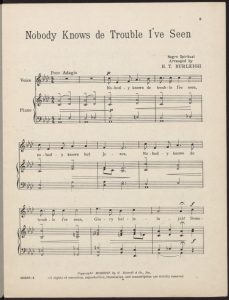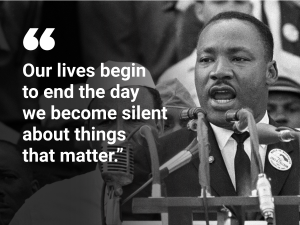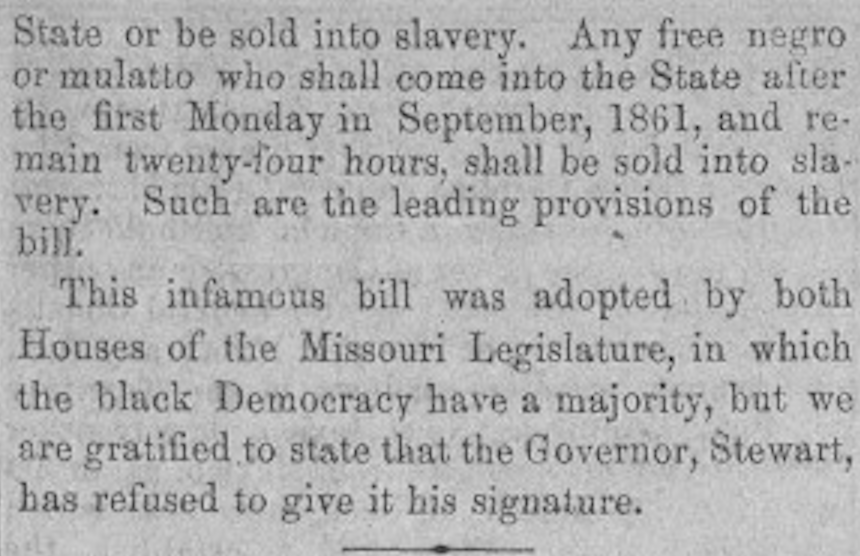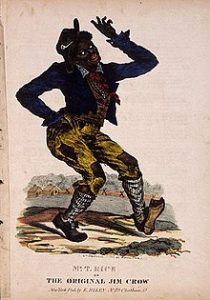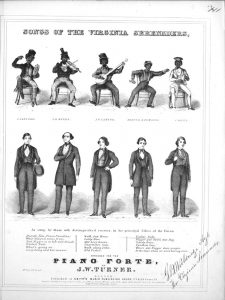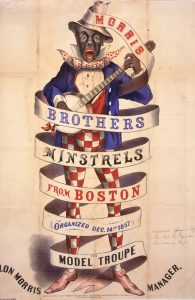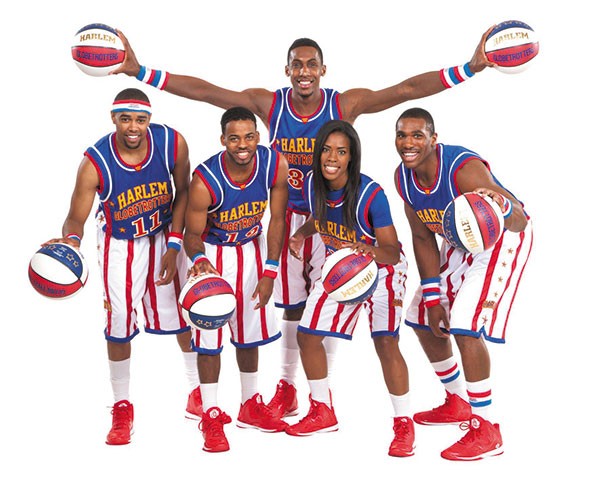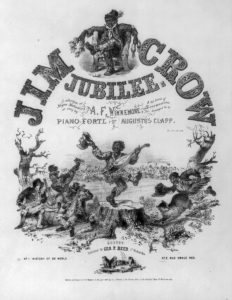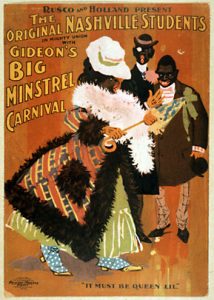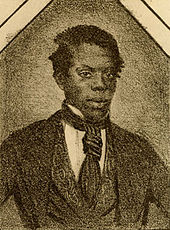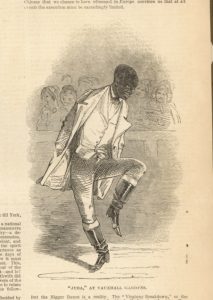Monthly Archives: March 2018
What Makes a Spiritual?
In combing through the archives to find documents that would be valid proof for my blog post, the problem of preservation and what counts as music that should be highlighted as an authentic expression of what it means to be a black American in the late 1800s kept bothering me and continues to do so.
Epstein notes the fact that the songs that were created by black Americans in the lat 1800s were not recorded for posterity, like corn songs.1
We know that there are a number of songs that failed to be preserved and passed down that told the experience of slaves, perhaps in a way that we will never know as present day audiences, far removed from that experience ourselves. However, in thinking about all of this and in looking through the archive, a question arose: how would a song like the one below fit in?
Clime up de Ladder to de Clouds. Composed by Gussie Davis. 1891. 2
This so-called ‘Ethiopian Song’ was written as a minstrel song but it retains the same elements of a spiritual. Furthermore, it was written by a black composer Gussie Davis. It arguably is at the very least inspired by the spirituals that were an established form of music by this time. Does this mean that it can be seen as a part of that tradition?
The lyrics themselves are the puzzle. As one can probably deduce, the song is about someone climbing up to heaven. There are multiple references to biblical objects like New Jerusalem and Satan which were also common in spirituals. Would it then fit the criteria of a spiritual?
If the answer to the question of whether or not it is a spiritual is that no, because it is a constructed form of music that is not an authentic experience, then why do the songs performed by slaves for their white owners for entertainment, documented by Southern, not fall into the same category? It has the same aspects of being a learned form, of falling into the “black entertainer with a white audience” category and placed the entertainer in a hazy sphere of identity.3
Does this change the perspective we have about “Clime up de ladder to de clouds”?
What about when we learn that Gussie Davis (who composed the song) grew up in Ohio and never experienced slavery?4 No I could not find a source for this, but would things be viewed differently if we found out that his parents had been former slaves? Or that he could directly point to a spiritual that had inspired this song?
Even though we may not agree that despite all of this, this song still does not have a place in the the spiritual tradition, it is still important to think about the questions this example raises. How do we understand what makes a black spiritual? Who gets to make it up? Does direct influence of spirituals or experience have to be explicitly affirmed or can we find other ways to hint at it? What would it mean if we included minstrel songs into the spiritual repertoire?
I don’t know if there are answers to those questions but they are worth thinking about.
Works Cited
1.Epstein, Dena J. Sinful Tunes and Spirituals : Black Folk Music to the Civil War. Music in American Life. Urbana: University of Illinois Press, 1977.
2. Davis, Gussie L., 1863-1899. Clime up de ladder to de clouds : Ethiopean song. New York: Hitchcock and McCargo Publishing Co., L’td.1891. http://digitalcollections.baylor.edu/cdm/ref/collection/fa-spnc/id/129736
3. Southern, E. (1971). “Entertainment for the Masters” inThe music of black Americans : A history. (1st ed.), 173-175. New York: W. W. Norton.
4. Saffle, Michael. “Davis, Gussie Lord.” International Dictionary of Black Composers, Vol. 1: Abrams-Jenkins. 374-78. https://search.alexanderstreet.com/view/work/bibliographic_entity%7Creference_article%7C1000081424.
Politics and Music: Reconciliation Through Celebration
1865 was one of the biggest years in the history of the United States of America. The end of the American Civil War was fast approaching and the 13th amendment was ratified early that year. Celebrations, both public and private, erupted all over the country. With these celebrations came some historic national firsts. One particular first came in a religious celebration that took place in the Capitol soon after the completion of the 13th Amendment. Reverend Henry Highland Garnet was invited by The Chaplain of the House of Representatives, Reverend William H. Channing to speak and perform religious ceremonies to honor this historic moment. 1
It was not only the first time that an African American preacher had performed a religious ceremony in the Capitol but, according to public letters, it was also the first time a black man had spoken there. 2 The significance of this event was not lost on Washington residents and both white and black men came to hear him speak. To further the momentous occasion congregants of the local black Methodist church, joined by a variety of members of nearby white churches, sang for the occasion. This interracial choir showcased both an ideological and political commitment to the expansion of rights for African Americans.
Spirituals are such an integral part of the African American experience, in many cases they represent hope and strength in times of strife. 3 It’s fitting that they would be included in such a historically important moment. The combination of politics, religion, and music symbolize the progressive and creative changes happening in the United States at this time. This celebration is ultimately representative of how music and ceremony can provide an outlet for people to come together and represent the multi-faceted nature of change. This moment in time shows how music can help to bring people together and how it can provide a platform for the celebration of progress.
Cultural Appropriation: Is It Bad?
From pop sensations Bruno Mars to Iggy Azalea to old school entertainers like Elsie Janis, musical cultural appropriation has always been and is still a problem to many people. Is music appropriation a bad thing? Here is some background to understanding why musical cultural appropriation is a problem.
First, before we get to it, we need to understand what “appropriation” means. According to TheFreeDictionary.com the definition of music appropriation is: “the use of borrowed elements (aspects or techniques) in the creation of a new piece,” (TheFreeDictionary.com).
Now, appropriation of music styles in itself is not bad. However, once those music styles are being re-interpreted by people who didn’t originally create that particular genre or song style, we start to find problems. This is called “Cultural Appropriation”. According to The Free Dictionary, “Cultural appropriation is the adoption or use of elements of one culture by members of another culture.[1] Cultural appropriation may be perceived[2] as controversial, even harmful, notably when the cultural property of a minority group is used by members of the dominant culture without the consent of the members of the originating culture; this is seen as misappropriation and a violation of intellectual property rights” (TheFreeDictionary.com).
An example of cultural appropriation is when someone who is not Mexican throws on a Charro suit as a costume for Halloween.
It is completely misrepresenting its origins. Cultural appropriation in music has been an issue in the Western world, especially in the United States. The reason is most, if not, all music that is “American” is originally black music. Most jazz, blues, ragtime, hip-hop, country, spirituals, and other songs we have discussed in class have found their origins in African-American culture.
Today, artists such as Bruno Mars and Iggy Azalea are being criticized for creating music in genres that originated from black musicians. Even after Bruno acknowledged his influences at the 2018 Grammy’s for example,
[Bruno Mars Acknowledges His Influences in 2018 Grammys]
an article was written about his role as a racially ambiguous artist in today’s music industry. Even Seren Sensei posted a video on Twitter defending her argument that Bruno Mars is using his racial ambiguity to further his credit in creating black music.
However, this issue is a bit more complex than it seems. To understand why, we must allude back to the cultural music appropriation of black music by white artists in the early 20th century United States.
[Elsie Janis – Anti Rag-Time Girl (Audio)]
2nd: Elsie Bierbower, aka: “Elsie Janis” was a singer, songwriter, actress and screenwriter from Columbus, Ohio. 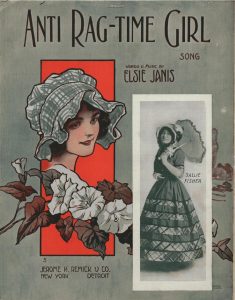 She moved to Los Angeles to live her dreams in the entertainment industry, and travelled around the world performing for vaudeville, Broadway and Hollywood. She was immortalized by her nickname, “the sweetheart of the AEF” when she would entertain the troops during World War I.
She moved to Los Angeles to live her dreams in the entertainment industry, and travelled around the world performing for vaudeville, Broadway and Hollywood. She was immortalized by her nickname, “the sweetheart of the AEF” when she would entertain the troops during World War I.
Elsie Janis could be described as a someone who made it in Hollywood. She was very famous in her time. However, as with everything that seems to good to be true, Elsie utilized ragtime, an African-American genre, to write her 1913 song “Anti-Ragtime Girl”. By 1913, Ragtime was in its prime as a popular American genre, similar to how hip-hop is dominant in mainstream culture today. It is clear that she uses ragtime to create this piece. Are her actions considered cultural appropriation? Yes and no. Yes, because she did not invent ragtime music, and it is clear that she is living lavishly for herself based off the income of her music’s success. Some may argue that it is not moral for one to use another’s culture to re-interpret in another perspective. It is still very complicated.
That leaves us with today. Eminem, Iggy Azalea, Bruno Mars, and Macklemore have all won Grammys for their success in performing music that is arguably black music. However, differences in opinion leaves us with an open-ended question: Where does the line between creating original art and committing cultural appropriation sit?
Sources:
Collins English Dictionary – Complete and Unabridged, 12th Edition 2014. S.v. “appropriation.” Retrieved March 19 2018 from https://www.thefreedictionary.com/appropriation
Harriot, Michael. “The Bruno Mars Controversy Proves People Don’t Understand Cultural Appropriation.” The Grapevine. Retrieved March 19 2018 from https://thegrapevine.theroot.com/the-bruno-mars-controversy-proves-people-don-t-understa-1823709412
Janis, Elsie. “Anti Rag-Time Girl.” Oregon Digital. Retrived March 19 2018 from https://oregondigital.org/catalog/oregondigital:w66343646#page/1/mode/1up
Sheet Music Singer. “Anti-Ragtime Girl (1913).” YouTube. Retrieved March 19 2018 from https://www.youtube.com/watch?v=anQzoJQZerk
Wikipedia.org. S.v. “Appropriation (music).” Retrieved March 19 2018 from https://encyclopedia.thefreedictionary.com/Appropriation+(music)
Harry Burleigh–A Nice Post for Once
We have been tackling some difficult ethical issues in this class regarding how we should feel and respond to the shameful reality of minstrelsy and its related veins. One conclusion we have come to is to acknowledge the past, recognize (white) America’s shortcomings, and point ourselves and others in the direction of something better. In my research for this post, I feel I have found that something better.

Sheet music for “Steal Away” arr. by H.T. Burleigh.
Complete sheet music here.
I came across the spiritual, “Steal Away,”1 the name of which I recognized as a song Viking Chorus sang during my freshman year. I found that the spiritual was arranged by Harry T. Burleigh, and reading about him was a little shining star in this (at times) depressing class. A rendition of the spiritual can be found on Youtube, among several others.
Harry Thacker Burleigh (b. 1866) is recognized as the first and among the most influential African American composers in post-Civil War America. He studied at the New York National Conservatory of Music where he became friends with Antonín Dvorák, who was the school’s director. They spent ample time together, Burleigh sharing with Dvorák the black spirituals and plantation songs that he had heard from his grandfather. Dvorák encouraged Burleigh to save these songs, to arrange them as his work.2 Thankfully, he did. “Steal Away” is one of the hundreds of pieces he arranged and composed. His most successful song is likely his arrangement of “Deep River” (1917), a song many people today recognize.3
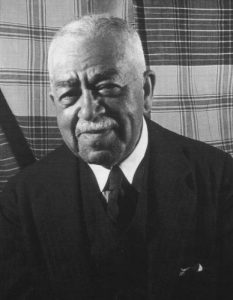
Photograph of Harry T. Burleigh by Carl Van Vechten
In the booklet of “Negro Spirituals” from which I found “Steal Away,” one of the first pages is a single page note from Burleigh on spirituals. Similar to the descriptions of spirituals Eileen Southern provides in Antebellum Rural Life,4 Burleigh outlines them as “spontaneous outbursts of intense religious fervor, and had their origin chiefly in camp meetings, revivals and other religious exercises”. He goes on to condemn the portrayals of blacks and their music in minstrel shows, declaring that the attempted humorous mimicry of “the manner of the Negro in singing them” is a “serious misconception of their meaning and value”.5
It is my belief that, with the knowledge of the shortcomings of American culture in our hearts, we should look to and celebrate those who do not fall into the questionable traditions we have encountered. I think Harry T. Burleigh is a splendid example. Thus, I would like to end this post with the ending words of Burleigh’s note in the booklet. He speaks of that value mentioned above, the true value of spirituals.
Their worth is weakened unless they are done impressively, for through all these songs breathes a hope, a faith in the ultimate justice and brotherhood of man. The cadences of sorrow invariably turn to joy, the message is ever manifest that eventually deliverance from all that hinders and oppresses the soul will come, and man–every man–will be free.
–H.T.B.
Let My People Go: Moses in African American Spirituals
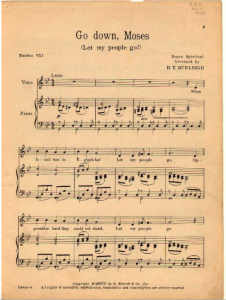
The traditional lyrics and melody. Burleigh, H.T. “Go Down, Moses (Let My People Go!),” in Negro Spirituals (New York: G. Ricordi, 1917),https://library.duke.edu/dig italcollections/hasm_n0708/.
After relentless, long and hard days working in the fields, enslaved black people had little in forms of comfort. Singing spirituals was one way for enslaved people to come together, to sing about their hardships, to praise God, and to lift their spirits. Although some scholars, such as George Pullen Jackson,1 have argued that spirituals stem directly from white Protestant music, spiritual songs centered on Moses and the Israelites’ escape from Egyptian slavery, such as “Go Down, Moses”, highlight how the slave experience distinctly shaped African American spirituals.
In the numerous songs featuring the biblical character of Moses, “Go Down, Moses” is the most popular. This as well as other Moses songs directly reflects enslaved people’s longing for freedom. For many enslaved people, Moses was representative of the brave “conductors” of the Underground Railroad, such as Harriet Tubman, that guided enslaved people to freedom.2 The lyrics of “Go Down Moses” indicating that Moses, someone who did not have as much power as the Pharaoh, could defy him and demand “to let [his] people go!” was incredibly powerful for enslaved people who dreamed of defying their master. In many ways it became a way of defying their master even if they did not run away.3
Although this version of “Go Down Moses” remains the most popular, other versions also highlight connections between the African-American slaves and the Israelites. In John Davis’s version of “Go Down, Moses”, he reveals that the chariot symbolizes the Underground Railroad and the “rivers rolling” as the rivers that runaway slaves would cross though to lose their scent.4 Although the lyrics are different, the message remains the same: a dream and a reflection on the fight for freedom.
Krehbiel’s assertion that “Nowhere save on the plantations of the south could the emotional life which is essential to the development of true folksong be developed”5 rings true in “Go Down, Moses”. Although whites may have shared Christianity with enslaved blacks, they could not emote the same connection with the enslaved Israelites. The emotion present in the slow, melancholy song in the video and sheet music above reveals the deep sadness of living in slavery and a longing for freedom that only enslaved people could understand.
1 Jackson, George Pullen. “Negro-Borrowed Tunes are Traced Back to Britain: Did the Black Man Compose Religious Songs?,” in White and Negro Spirituals, Their Life Span and Kinship: Tracing 200 Years of Untrammeled Song Making and Singing Among Our Country Folk, (New York: J.J. Augustin, 1943): 264-289.
“The Voice is not nearly so important as the Spirit”
After reading Eileen Southern and Dena Epstein’s accounts of American slave songs and particularly spirituals, my curiosity was piqued. I set out to see what sheet music for spirituals looked like from the days of the sheet music craze and naturally ran across something I wasn’t really expecting.
What I found was H. T. Burleigh’s arrangement of “Sometimes I feel like a motherless child” for low voice and piano.1 One thing that initially struck me about the song was that it fit with what Epstein wrote about as a common theme in slave songs, that is the repetition of the same line of text several times in a row. Another common characteristic was syncopation, which is also an important driving characteristic of this song.2
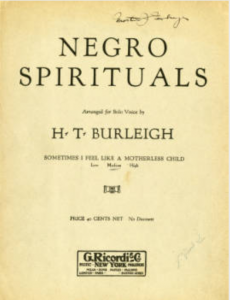
The cover of the sheet music for “Sometimes I feel like a motherless child”. A recording of this arrangement can be found here.
However, arrangement is also interesting because it has been written in the style of arias and art songs. The melody is written out clearly, omitting some of the vocalizations that perhaps would have been sung by slaves. It is also made clear that the song does not perhaps fully fit a European method of transcription by the footnote on the first page which offers an alternate rhythm for one of the measures. Additionally, the arrangement contains a simple piano accompaniment consisting mainly of repetitive chords on the beats. This makes sense as the arranger, H. T. Burleigh studied on scholarship at the National Conservatory of Music in New York and ultimately became famous for being the first to arrange spirituals in the style of art songs, allowing for their entry into recital repertoire.3
The other interesting aspect of this sheet music is the arranger’s note that precedes it. In it, Burleigh gives a brief history of spirituals and claims that they are “practically the only music in America which meets the scientific definition of Folk Song”. He then goes on to advise the would-be singer that “the voice is not nearly so important as the spirit” when preforming, and that rhythm is the critical element. He admonishes that spirituals should not be linked with “minstrel” songs and that one should not try to imitate “Negro” accent or mannerisms in performance.
Ultimately, this got me thinking again about our discussion question of who gets to sing these songs and who gets to decide who gets to sing them? This arrangement was obviously originally intended for a white audience because of its warning about trying to perform them imitating the ways that are “natural to the colored people”. Written as it is in the style of an art song, means it caters to recitalists. Most recitalists of the time were white, as Burleigh himself is regarded as one of the first African American recitalists. Can white performers sing these songs that came out of the deep anguish of slavery and do them justice?
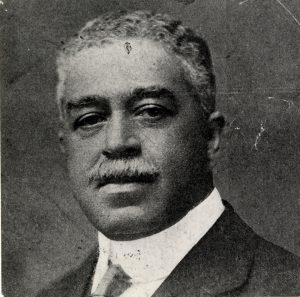
H. T. Burleigh (1866-1949).
Burleigh also adds an interesting dimension to the puzzle. As a black man born after the abolition of slavery, does he still have a right and connection to these songs? After all, he came from a poor family and learned many of his spirituals from his grandfather, who had been a slave.4 Furthermore, Burleigh still lived in a time of deep racial inequality and probably experienced ugly racism and discrimination in his own life.
Perhaps Burleigh, in is own way, provides a bit of an answer to this quandary in his performance notes when he remarks that spirituals’ “worth is weakened unless they are done impressively, for through all these songs there breathes a hope, a faith in the ultimate justice and brotherhood of man”. It may not be a perfect answer, but it is something.
1Burleigh, H. T. “Sometimes I feel like a motherless child” from Negro Spirituals. New York: G. Ricordi, 1918. http://digital.library.temple.edu/cdm/ref/collection/p15037coll1/id/5400. Accessed March 19, 2018.
2Epstein, Dena J. Sinful Tunes and Spirituals: Black Folk Music to the Civil War. Urbana: University of Illinois Press, 1977.
3““Harry” Burleigh (1866–1949).” In African American Almanac, by Lean’tin Bracks. Visible Ink Press, 2012. https://ezproxy.stolaf.edu/login?url=https://search.credoreference.com/content/entry/vipaaalm/harry_burleigh_1866_1949/0?institutionId=4959. Accessed March 19, 2018.
4Snyder, Jean. “Burleigh, Henry [Harry] T(hacker).” Grove Music Online. http://www.oxfordmusiconline.com/grovemusic/view/10.1093/gmo/9781561592630.001.0001/omo-9781561592630-e-1002248537. Accessed March 19, 2018.
Lullabies and Mother-Child Relationships in Slavery
The focus on slave songs this past week provided important insights into the lives of slaves in the late eighteenth and early nineteenth century. In Eileen Southern’s book The Music of Black Americans, she details the ways in which the growing slave population in the South experienced music in their everyday lives.[1] It’s fascinating to learn not only about the songs’ significance, but also how this music has been recorded and preserved over time.
Southern briefly touched on the role of song in dance in recreation. This piqued my interest in one element of slave culture touched upon less in the readings for the week: slave family life. Those with only minimal knowledge of slavery in the United States understand that stable and cohesive families were rare. It was not uncommon for children and their mothers to be separated from their fathers.[2] Nevertheless, recreation and resilient familial relationships were an enduring silver lining.
While perusing the African American Historical Newspaper Collection, I came across one especially intriguing article that reflected this theme and, in particular, the mother-child relationship in slavery.[3] The excerpt displays a letter from Francis Jackson to President Zachary Taylor, calling for him to abolish slavery. In the letter, Jackson appeals to President Taylor by referencing the bond between slave mothers and their children.
He questions the President’s morals if he continues to permit slavery after acknowledging its cruelty, as evidenced in part by the separation of mothers and their children. This led me to wonder: in what ways did the mother-child relationship in slavery intersect with the music created and preserved on the plantation? Did parents, and more specifically – mothers – have a distinct way of connecting through music?
My research led me to an online feminism project from Brandeis University, which features a collection of information about slave lullabies.[4] Lullabies are typically thought of as soothing melodies sung to calm children. The authors here describe the ways in which slave mothers cared for and nurtured their children through lullabies, despite the lack of agency associated with their motherhood. One excerpt reads:
“Slave songs about mothering open a window into these women’s hearts. Many of these lullabies have come down to us as words only—their tunes are lost—but they resonate nevertheless. Their lyrics reveal an ever-present sense of danger and pain; they whisper sweet promises of a brighter future; and, as lullabies have always done, they serve the practical purpose of making children ‘sleep good, feel better and have something to hope for.'”
This project website includes several original texts written by slave mothers, many of which have been adapted and are recognizable today. Included below is believed to be one of these adaptation: a recording of a song from the 2000 film O Brother Where Art Thou. These lyrics are similar to a poem entitled “Go to Sleepy,” written by Annie Little, who, reportedly, sang her 10 enslaved children to sleep with these lyrics.
Understanding the origins of songs and lullabies we know today, such as those derived from texts documented in this project, can go a long way in preserving slave songs. Lullabies were one way slave mothers could use music to provide comfort, and reflecting on this history allows us to appreciate how music played a part in the complexities of the slave familial relationships.
[1] Southern, Eileen. “Antebellum Rural Life.” In The Music of Black Americans: A History, 151-204. New York: W. W. Norton & Company, 2006.
[2] Williams, Heather A. “How Slavery Affected African American Families.” Freedom’s Story, TeacherServe®, National Humanities Center. Accessed March 20, 2018. http://nationalhumanitiescenter.org/tserve/freedom/1609-1865/essays/aafamilies.htm.
[3] Jackson, Francis. “Letter to President Taylor.” The North Star (African American Historical Newspaper Collection), March 22, 1850.
[4] Tick, Judith, and Melissa J. De Graaf. “Slave Lullabies in the American South: Mothers’ Voices Recovered.” The Feminist Sexual Ethics Project. Accessed March 20, 2018. https://www.brandeis.edu/projects/fse/slavery/lullabies/index.html.
Understanding Abolitionism in Music: The Hutchinson Family Singers and Frederick Douglass
While looking through the database “African American Newspapers” for references to music, I came across a letter regarding a recent concert by the Hutchinson Family Singers for Henry Clay that included music thought to be abolitionist in nature.1 Published on in New York on March 22, 1848, this letter, from “L.P.” is addressed to Frederick Douglass, politely suggesting an alternate account of a performance Clay that Douglass had criticized.
According to L.P., the Hutchinsons sang rousing abolitionist music, some of which had been added to in order to be more abolitionist. Douglass’s complaint was that the traditionally abolitionist Hutchinsons2 had gone over to the other side, singing in honor of Henry Clay, an American legislator who owned slaves but supported gradual emancipation.3 L.P., however, wished that “would to God that the Hutchinson Family might sing before every slaveholder in the land; the effect would be to greatly hasten on the ‘good time coming,’ when every slave should be emancipated, and mankind should love each other.” While the controversy of this performance is fascinating, diving into the songs mentioned in the article as abolitionist songs unearths an interesting contrast between these “abolition” songs and contemporaneous slave songs that yearned for freedom.
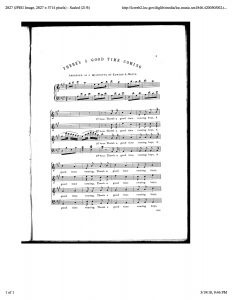
Sheet music for “The Old Granite State” from 1843. Verses about abolitionism and temperance were later added.
Once song mentioned in the 1848 article is “The Old Granite State.” Referencing 1843 sheet music for the song, repetitive lyrics suggest abolitionist themes such as refuge in the mountains, and feelings of brotherhood.4 For a song meant to persuade the country to support emancipation and learn to love one another, however, the song falls short in retrospect. Upon further research however, it appears that the additional abolitionist verses mentioned by L.P. had not been added in 1843. As heard in a 2006 recording, additional verses dealt with the subject of slavery and emancipation.5
Liberty is our motto, (3x)
In the Old Granite State,
We despise oppression,
And we cannot be enslaved.
Yes we’re friends of Emancipation
And we’ll sing the Proclamation
Till it echoes through our nation
From the Old Granite State.
That the tribe of Jesse,
That the tribe of Jesse,
That the tribe of Jesse
Are the friends of equal rights.6
It is quite evident from these verses that the Hutchinson’s demonstration of abolitionism was tightly tied to their New England pride. For example, this song that the article’s author claims could persuade slaveholders to support emancipation is named “The Old Granite State,” a nickname for New Hampshire.
The Hutchinsons’ and L.P.’s understanding of emancipation and the need for freedom as expressed through song appear to be quite different that of the slaves themselves. Instead, many slave songs dealt with themes of Christianity, and the need to hold onto God’s love in order to get to a better place, spiritually and physically. Songs like “Go in the Wilderness” were rooted in the reality of slavery, and the need to escape through faith, hope and perseverance. Singing was a way of survival.7 The Hutchinsons, however, chose to use music to express their belief in abolition and temperance through the lense of their New Hampshire pride. While there is no reason that the Hutchinson’s song for emancipation and slave songs should be exactly the same, it is important to note the different tones that each take, as it is reminiscent of parallel differences between African Americans and white northerners about the importance of freedom and equality in comparison to other social issues.
Perhaps, then, Douglass was right to chide the Hutchinson’s for their mild claim to abolitionism. Could a family of white New Englanders be adequate ambassadors for abolition to Henry Clay? Or perhaps there was something truly special about the way the Hutchinson Family Singers performed on that night, as the author of the article claimed.
1 L.P. “The Hutchinsons.” The North Star (Rochester, New York). March 22, 1848. America’s Historical Newspapers. Accessed March 19, 2018.
2 “Hutchinson Family.” In The Harvard Biographical Dictionary of Music, edited by Don Michael Randel. Harvard University Press, 2003. https://ezproxy.stolaf.edu/login?url=https://search.credoreference.com/content/entry/harvbiodictmusic/hutchinson_family/0?institutionId=4959.
3 Gigliotti-Gordon, Kate. “Clay, Henry.” In Encyclopedia of African American History, 1619–1895: From the Colonial Period to the Age of Frederick Douglass. : Oxford University Press, 2006. http://www.oxfordreference.com/view/10.1093/acref/9780195167771.001.0001/acref-9780195167771-e-0122.
4 Hutchinson, Edward L White, and Charles Mackay. There’s a Good Time Coming, Ballad. Oliver Ditson, Boston, monographic, 1846. Notated Music. Retrieved from the Library of Congress, Accessed March 19, 2018. https://www.loc.gov/item/sm1846.420050/.
5 Saletan, Tony and Irene Kassoy. “The Old Granite State” Folk-Legacy Records, Inc. 2006. Post to YouTube Oct. 11, 2014. Accessed March 19, 2018. https://www.youtube.com/watch?v=IZgl6kzlztU.
6 Hutchinson Family. “The Old Granite State” The Mudcat Café. Accessed March 19, 2018. https://mudcat.org/@displaysong.cfm?SongID=6775.
7 Southern, Eileen. The Music of Black Americans. New York: W.W. Norton & Company, Inc., 1971. Pg. 106.
Who gets to be American?
 People of color are often treated as as outsiders and struggle to be viewed as fully American, rather than a hyphenated version of it. Much of this is rooted in the fact that it was not until relatively recently that people of color in the United States were even considered citizens. Now, even those who are American citizens constantly have to prove that they are “American” enough. A key characteristic of a “normal” American that is implied but never explicitly stated is that one must be white. Without whiteness, loyalty to the United States as well as true “Americanness” is always questioned.
People of color are often treated as as outsiders and struggle to be viewed as fully American, rather than a hyphenated version of it. Much of this is rooted in the fact that it was not until relatively recently that people of color in the United States were even considered citizens. Now, even those who are American citizens constantly have to prove that they are “American” enough. A key characteristic of a “normal” American that is implied but never explicitly stated is that one must be white. Without whiteness, loyalty to the United States as well as true “Americanness” is always questioned.
The assumption that one must be white to be American is visible in the history of black spirituals. In Afro-American Folksongs: A Study in Racial and National Music by Henry Edward Krehbiel, the exclusion of black spirituals within the label of “American folk music” is highlighted. Krehibel explains how many writers acknowledge the “interesting character of the songs, but refuse them the right to be called American” (Krehibel, 1962). This denial of “American” status is continually brought up throughout Krehibel’s writing. After all, “they were created in America with American influences and by people who are Americans in the same sense that any other element in our population is American” (Krehibel, 1962). Well, all except one thing: they weren’t white.
Creating boundaries to determine who is and is not really American is evident in this article from a newspaper from the Freedom’s Journal written in 1828. This was written by a black man educated in the North about his travel experience to Maryland, a state where slavery was still widely present at the time. When describing his experience in Baltimore he states that a black man from the north can never feel at home because:
“when we come to talk of liberty – of the rights of citizenship – of his evidence in a court of justice against his fairer brethren, we cannot but perceive that there is little justice doled out to [a man of colour]”
It does not matter that this man is from the north and educated. He still will not be treated as having the same rights of citizenship as a white man. This history around citizenship and rights of black people contributes to the modern conception of who is “American”. The deeply embedded racism in slavery and later in determining citizenship status caused black people to struggle to gain American citizenship. This contributes to the reason why the default race of an American is white. This notion, however, is not only attributed to citizenship status, as even currently, people of color who are American citizens since birth still have to prove that they belong. Maintaining whiteness as the norm prevents people of color from being included in the status of “American” just as black spirituals were excluded from being considered American folk music. This exclusion helps to maintain the unjust treatment of people of color in the United States by pinning them as outsiders and not truly American.
Sources:
Fort Dearborn Publishing Co. Map of the United States of America. 1901. Retrieved from the Digital Public Library of America, http://ark.digitalcommonwealth.org/ark:/50959/3f4636795.
Henry Edward Krehbiel. Afro-American Folksongs: A Study in Racial and National Music. New York: Frederick Ungar Publishing Co., 1962.
“Travelling Scraps.” Freedom’s Journal (New York, NY), August 15, 1828.
Different Times, Different Troubles (Same Song)
It’s hard to definitely say someone should not sing certain music. When it comes to spirituals, we wonder if the music was supposed to be passed down the generations, or if it was supposed to be left behind, where it could only be associated with slavery and sorrow.
H.T. Burleigh thought such music should be remembered, as he is famous for having arranged the music for many spirituals, including “Nobody Knows de Trouble I’ve Seen”. Burleigh and others published a variety of other arrangements for “mixed chorus, men’s chorus, and women’s chorus”.1
Therefore, it is clear he intended these songs to be sung by a variety of people for generations to come. He believed that spirituals have worth to anyone and everyone. He even made a statement on the second page of this sheet music, warning not to sing these songs as if a “minstrel” performance, mocking the mannerisms of African Americans while singing the song, but instead to respect the value of such musical works:
“Their worth is weakened unless they are done impressively, for through all these songs there breathes a hope, a faith in the ultimate justice and brotherhood of man. The cadences of sorrow invariably turn to joy, and the message is ever manifest that eventually deliverance from all that hinders and oppresses the soul will come, and man–every man–will be free.”2
If a choir of white people gave a lively and vigorous performance of this spiritual or any kind like it, it would come across as disrespectful. Slaves were not allowed to sing work songs mournfully, even though the songs were of sorrow and of trouble.3 “Douglass observed in the 1845 edition of his autobiography that slaves sang most when they were unhappy”.4 A smiley performance of such music seems inappropriate. People today cannot properly fathom the hardships that slaves endured back then, so for anyone other than slaves to sing these songs does not feel right. However, Burleigh might argue that spirituals transcend the history. The music can mean a lot to a lot of people, even if for different reasons.
Perhaps it would help to imagine slaves’ reactions to performances of their songs today. They could think it beautiful that their music has survived so long and that their time is not forgotten or brushed aside as insignificant in history. However, their reaction would probably depend on what performances they see–whose singing for whom and for what reason. They could definitely find it disturbing that their music is occasionally sung out of context for the pleasure of white people listening. But what would they think if they saw a choir in Taiwan singing one of their songs?
We can’t know for sure what they would think, but perhaps if the music is performed in a respectful manner, it can mean more for more people.
1 “H. T. Burleigh (1866-1949).” Library of Congress. https://www.loc.gov/item/ihas.200035730.
2 Burleigh, H.T. Nobody knows de trouble I’ve seen. New York: G. Ricordi & Co., Inc., 1917. Retrieved from Sheet Music Consortium, http://digitalcollections.baylor.edu/cdm/ref/collection/fa-spnc/id/23714.
3 Eileen Southern, The Music of Black Americans: A History (New York: W.W. Norton & Company, Inc., 1971), 161.
4 Eileen Southern, The Music of Black Americans: A History (New York: W.W. Norton & Company, Inc., 1971), 177.
Amos ‘n Andy: An American Legacy
In trying to come up with this blog post, I decided to take my inspiration for a research topic from the readings for class about the legacy of minstrel shows. The one I found the most striking and complex was a popular radio show (and short lived TV show) called Amos ‘n Andy.

Charles Correll and Freeman Gosden in blackface as “Amos” and “Andy”. Circa 1931 1
Written and performed by two white actors, Amos ‘n’ Andy started as a regional Chicago radio show named Sam ‘n’ Henry. Within a few years and a name change the show was broadcasted nationally and eventually became the most popular show of its kind. Other shows were called Burnt Cork Review, Aunt Jemima and Plantation Party. 2 which should give a hint to the idea that these shows were the offspring of the minstrel tradition. All told, the radio show ran in some form (nightly or weekly) for a total of 32 years from 1928 to 1960. There were a number of other plays and even at least one movie that I found inspired by those characters along with a number of commercial items like toys and buttons.
Amos ‘n’ Andy relied on the humor and formula that had worked in the not-so-distant past in minstrel shows. It was a direct legacy of minstrel shows in more ways than one. It was an immensely popular show that ran for years, even through the Great Depression. In fact, the two actors on the show were two of the highest people paid in the years of the Depression. The clearest example of the legacy of minstrelsy in the show was the way humor was manufactured: the actors used dialect and slapstick comedy for laughs, the two main characters were two forms of the stereotypical characters that had appeared on so many minstrel shows. They were both naive bumpkins who were prone to mishaps and general buffoonery.

Cast of Amos ’n’ Andy. Alvin Childress as Amos Jones (left), Tim Moore as George “Kingfish” Stevens (center), and Spencer Williams as Andrew Hogg Brown (right)
The TV show that was on air from 1951-1953 featured an African American cast who, although they may not have been using actual blackface but were instructed to keep to the dialect and voices of the original actors thus creating a form of virtual blackface. The show was short lived because of a formal protest by the NAACP who felt the show was a series of racist portrayals that were contributing to a negative opinion of African Americans. This is direct evidence of the changing role and acceptance outlined in our readings and seen in the culture as mentioned by Stephen Johnson when he talks about the blackface appearance of Pat Paulsen that never aired.3
Amos ‘n Andy was a good example of the legacy minstrelsy has left behind in this country. It also reflected the shifting dynamics of the country because of the way the NAACP was able to successfully protest against the TV show and get the network to cancel it. Yet, while the TV show was protested against and cancelled, the radio show continued to play in the background. The ambiguity of the minstrel show is left behind too because like you can see in the picture at the top, the actors would appear in blackface as their characters like the minstrel shows but would later go on to comment that they felt their show did not a negative depictions of African Americans. Not to mention the fact that the show was an extremely popular American phenomenon demonstrating the enduring appeal of the minstrel shows even though the format of the it changed.
1 Unidentified Artist. Amos ‘n’ Andy. c. 1935. Retrieved from the Digital Public Library of America, http://collections.si.edu/search/results.htm?q=record_ID%3Anpg_NPG.96.205&repo=DPLA. (Accessed March 8, 2018.)
2 Dobson, Frank E. “Amos ’n’ Andy.” In Encyclopedia of African American History 1896 to the Present. : Oxford University Press, 2009. http://www.oxfordreference.com/view/10.1093/acref/9780195167795.001.0001/acref-9780195167795-e-0056.
3 Johnson, Stephen, ed. Burnt Cork: Traditions and Legacies of Blackface Minstrelsy. University of Massachusetts Press, 2012. http://www.jstor.org/stable/j.ctt5vk2wm.
4 Young, William H. “Amos ‘N’ Andy (Radio and Tv, 1928).” In The American Mosaic: The African American Experience, ABC-CLIO, 2018. Accessed March 8, 2018. https://africanamerican2.abc-clio.com/Search/Display/1483015.
Activism: A Rant on Music, Minstrelsy, New Orleans, and Today’s Racism
“Minstrelsy is thing of the past!” my old high school teacher once told me. Is it actually a thing of the past? Just because it is no longer featured and accepted in mainstream media it does not mean that the racism in the United States has ended. It has only evolved. We still hear remnants of this racist entertainment culture in sing-along songs that have been played to many children growing up. There are still references made to minstrelsy through the use of costumes in cartoons such as Mickey Mouse. Have African-Americans, or minorities in general, ever been put first when it comes to economic and emergency aid from the United States government or population? If so, why did Cesar Chavez or Martin Luther King, Jr. ever have to step on that soapbox to put minorities first themselves?
Is it a cultural norm for the United States to be considered a nation that puts their people last? Unlike the Swiss and Germans, who have helped their people in times of need, New Orleans says a lot about the reality of the United States and the government’s attitude towards affirmative action aimed at minorities, specifically African Americans.
“While Swiss and German governments have paid reparations to Holocaust survivors and those killed in the Holocaust, black intellectuals have pointed out that there has been no such concentrated effort by the United States to repay African Americans for the unpaid labor required under slavery” (The American Mosaic: The African American Experience).

Looters make their way into and out of a grocery store in New Orleans on Tuesday, Aug. 30, 2005. Flood waters continue to rise in New Orleans after Hurricane Katrina did extensive damage when it made landfall on Monday. (AP Photo/Dave Martin)
In 2005, Hurricane Katrina killed over 1,800 people and changed the lives over millions of others. One of the cities most affected by this hurricane was New Orleans, LA. The majority of the people affected by this disaster were African-Americans. According to DataUSA.io, the 75.8% of the New Orleans population is Black, 18.9% is White, and 5.3% is Hispanic.
“The problems that plague the urban poor, who are disproportionately African American, were tangible throughout Louisiana—especially in New Orleans, which sustained the most damage—and in Mississippi near where the storm made landfall. The catastrophic storm only amplified ways the black urban and rural poor in the American South had been ignored” (The American Mosaic: The African American Experience).
It is clear that a disproportionate amount of African-Americans in this part of the South were left without sufficient aid by the US Government emergency systems. According to the article about “New Leadership,” Sanders states that there are many African American intellectuals today drawing on evolving conversations about black identity to “reignite a debate on the need for reparations to African Americans” (Sanders). This debate is similar to that of minstrelsy in the context of African American reparations. What can the United States offer to African Americans as reparations in a post-slavery world? Does the United States do enough for African Americans today? This question is complicated because we must define “United States”. The United States as in: government, citizens, immigrants, and companies. There are many different ways the United States can act as an entity.
Minstrelsy poses the same concerns because it requires reparations in its own context. The question posed with regard to minstrelsy is, “Should minstrel songs and culture be erased from history or should we educate our following generations on its history?” For lack of a better way to state this, I will say it as it is: The United States as a whole is not doing everything it can do to owe reparations to African Americans today.
Sources:
- Sanders, Joshunda. “New Leadership, 2001–2008.” In The American Mosaic: The African American Experience, ABC-CLIO, 2018. Accessed March 7, 2018. https://africanamerican2.abc-clio.com/Topics/Display/39.
- The Black Law in Missouri. The National Era (Washington D. C., United States), Thursday, January 26, 1860; pg. 15; Issue 682 (224 words (1860/01/26/): https://goo.gl/P7Ahw6
- https://datausa.io/profile/geo/new-orleans-la/#ethnicity
- Simpson, George. “Disney race shock: Mickey Mouse ‘was based on blackface minstrels’.” Express.co.uk. February 3, 2017. Accessed March 7, 2018. https://www.express.co.uk/entertainment/films/762722/Disney-racist-Mickey-Mouse-gloves-blackface-minstrels-Vaudeville-The-Opry-House.
“Carry Me Back to Old Virginny”–how should we feel about it?
In our readings and listenings on minstrelsy, we have come across the minstrel song, “Carry Me Back to Old Virginny,” a sentimental tune seeming to long for simpler slave life back in the South. In an address to the State Legislature of Missouri, Dr. Joseph McDowell mentions this song as “the song of the old African,” arguing that it holds such a special place in the hearts and minds of former slaves because “no negro over left her soil but carried in his bosom a desire to return, and a vivid recollection of her hospitality and kindess”.1 The lyrics, pictured below, begin “Carry me back to old Virginny, There’s where the cotton and the corn and tatoes grow…. There’s where the old darkey’s heart am long’d to go.”
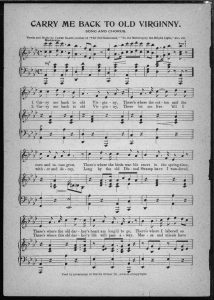
“Carry Me Back to Old Virginny” notated music, composed by James Bland. https://www.loc.gov/item/ihas. 200000735/
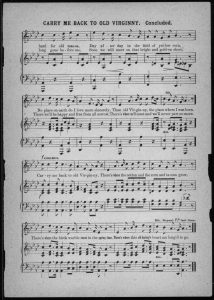
“Carry Me Back to Old Virginny” notated music, composed by James Bland. https://www.loc.gov/item/ihas. 200000735/
Written in 1878, the song was a “longtime staple” of minstrel shows2, a renowned favorite, bearing what we would deem now to be controversial lyrics. It was performed by many minstrel troupes, notably by the Georgia Minstrels, the “first successful all-black minstrel company,” of which the composer of this song was a prolific member.3 Furthermore, in 1940, the song was adopted by the state of Virginia as the official state song, and remained as such until 1997 when it was withdrawn due to complaints that the lyrics were racist, and was instead made the state song emeritus (an honorary state song).4
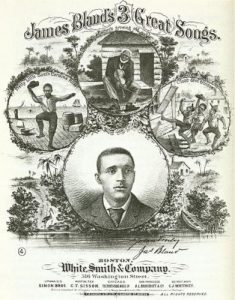
James Bland’s 3 Great Songs
http://www.blackpast.org/files/ blackpast_images/James_A__Bland __public_domain_.jpg
The element of this that I find most intriguing and complex is that the song was written by a black man, James Bland, to be performed in blackface minstrelsy. As we discussed in class, white people performing in blackface is an inappropriate and, quite frankly, a disgusting practice, but the morals get a bit trickier when it comes to black people performing in blackface. Bland used minstrel shows to his professional and financial benefit, using the stage as a platform to broadcast his musical compositions.5 In light of this, should we reconsider his song, “Carry Me Back to Old Virginny”? Is this a racist song? Or could it be a satire, “illustrating Southern white slaveholders’ longing for the past when they were masters and African Americans were under their subjugation”?6 Either way, is it wrong to discount a song that was a prominent feature of a man’s career that likely would not have come to fruition if it wasn’t for the popularity of minstrel shows, for better or for worse, blurring the color line and giving blacks the opportunity to participate in American popular culture?
Jim Crow: Song, Character, and Symbol
The character of “Jim Crow” has had a long and varied life. Most commonly known as the term for racism and segregation in the American south post-emancipation, the Jim crow was first popularized in the early nineteenth century through song and minstrelsy. Coming out of the song “Jump Jim Crow,” the character was physically manifested in blackface minstrelsy by white male performers. The exact origins of Jim Crow within the song are fuzzy, yet that did not seem to matter to Thomas Rice, the “father of minstrelsy,” who created a caricature out of Jim Crow.1
Although there are variations on the tale, the story goes that Thomas Rice, a white actor originally from New York City, had the idea to create the blackface character of Jim Crow after hearing a black man singing “Jump Jim Crow.”2 In a grotesque impression, Rice integrated the song and character into his traveling show. This early version of Jim Crow had one primary purpose: to make a profit for Thomas Rice by capitalizing on the willingness of white Americans to laugh at racist stereotypes. Despite the role that Jim Crow, and the song “Jump Jim Crow” played in perpetuating stereotypes by becoming the face and name of racism, the original intent was to make money by capitalizing on the social situation that already existed.
As a song written before Emancipation, Thomas Rice’s version of “Jump Jim Crow” is not especially remarkable in terms of its stance on race. Sung in a stereotypical “black” dialect, it tells the story of Jim Crow’s journey through the south from his perspective. He is presented as a violent man, who hits other people at least twice, and as a crazy man, who sits on sits on a hornet’s nest, and eats an alligator.3 The tune is jaunty and catchy, and the chorus is repeated frequently. Typical of its portrayal of black men by white men for the time, “Jump Jim Crow” provided an effective combination of catchy tune with an easily replicable character, making both the song and the blackface character financially profitable for Thomas Rice. Due to the success of this song and persona, Rice became one of the first blackface minstrels, touring the country with other productions such as “Ginger Blue” and “Jim Crow in London.” Rice commercialized and standardized the transfer of a little-known song into a profitable product that radicalized the racial stereotypes already present, and set the precedent for blackface minstrelsy characters and songs to come. From a character in a song, Jim Crow grew into a cultural marker of all that was wrong with white Americans’ attitudes and treatment of black Americans. Today, “Jump Jim Crow” is being re-appropriated without blackface. In the first clip, above, a man sings “Jump Jim Crow” without any “dialect” and without some verses. This version is much more languid than a modern instrumental version, linked below. The question remains of how much weight should be given to the connection between the song, the character, and the legacy of blackface minstrelsy.
1 “Jump Jim Crow.” History of Minstrelsy: From “Jump Jim Crow” to “The Jazz Singer.” http://exhibits.lib.usf.edu/exhibits/show/minstrelsy/jimcrow-to-jolson/jump-jim-crow/
2 Burns, James. “Thomas Rice.” In The American Mosaic: The African American Experience, ABC-CLIO, 2018. Accessed March 8, 2018. https://africanamerican2.abc-clio.com/Search/Display/1606088.
3 Jump Jim Crow, C Major. Viking Press, 1937. https://search.alexanderstreet.com/view/work/bibliographic_entity%7Cscore%7C771896.
Masculinity and Minstrelsy: Intersectional Issues in Blackface Performances
As long as the entertainment industry has sought to reach the masses it has caused controversy. Minstrel shows, the first form of mass entertainment in the United States,1 is one of the most prolific examples of this. Minstrelsy relied heavily on songs and dances performed in blackface, the act of covering one’s face in burnt cork to give the illusion that the actor or actress is black themselves. Characters that were in blackface were played as caricatures of stereotypes in the African American community.
These performances not only relied on racist notions of identity but also gendered ones. White male performers could experiment with identity and commodify it by playing on the entertainment quality of challenging racial and gendered notions of identity.2 Thomas Rice, the actor who created the Jim Crow character, is one example of these performers.3 The Jim Crow character was modeled as a former slave who wished to return to the way things had been during the antebellum years. During and after reconstruction real, living, breathing black American men lived in fear and persecution due to racist beliefs that created a scary and wild image of them. Minstrel shows furthered these images by showcasing them as stupid and brutish. The Jim Crow character was an emasculating and oftentimes pitiful version of the African American man.4 This portrayal stood as a stark contrast from the expectations of white men during this time period. A poster from a five person minstrel show shows this contrast. In it you can see through their difference in posture, clothing, and personality the inferiority of their African American characters.
Jokes at the expense of the African American men were the real cherry on top. For example, the Jim Crow character’s wish to return to plantation life also included his desire for the protection of his master. This falsely portrayed wish for domination says more about white men than it does about their black counterparts. It exhibits the racist and sexist values of the United States and the too slow change in societal acceptance. Minstrelsy was a popular and important part of the American entertainment industry. Like many forms of entertainment, though, it helped to fuel the fire of hate a prejudice and that cannot be forgotten.
1 Weiner, Melissa F. “Minstrelsy.” In The American Mosaic: The African American Experience, ABC-CLIO, 2018.
2 Locke, Joseph. “Blackface.” In The American Mosaic: The African American Experience, ABC-CLIO, 2018.
3 Burns, James. “Thomas Rice.” In The American Mosaic: The African American Experience, ABC-CLIO, 2018.
4 Nuruddin, Yusuf. “Jim Crow Racial Stereotypes.” In The American Mosaic: The African American Experience, ABC-CLIO, 2018.
Minstrelsy Today: What It Looks Like and What We Do About It
Minstrelsy refers to the form of musical stage entertainment in the 19th and early 20th century that sought to parody black slave culture. The hallmark feature of minstrel shows was the use of blackface – white actors covering their faces with burnt cork to appear as and make fun of African Americans. Today, white Americans hear the words “minstrel show” and cringe with embarrassment. How could something seemingly so racist have been such a popular form of entertainment? Despite a more thorough acknowledgement of the ways in which racism has plagued our country for centuries, it would be a crime to ignore remnants of minstrelsy in our society today, and subsequently, to dismiss the conversation surrounding whether we reclaim or ignore elements of minstrelsy today.
When exploring minstrel-related themes on the African American Experience database, I was struck by one particular image. The image (left) depicts an advertisement for the Morris Brothers Minstrel group.[1] The figure’s blackface and bright, big red lips are obvious features, and his banjo emphasizes the theatrical portion of the traditional minstrel show.
The costume is striking when compared side-by-side with an image of the Harlem Globetrotters (below), an exhibition basketball team who combine athletic ability, comedy, and theater on their wildly successful tours. The Harlem Globetrotters represent a prime example of contemporary form of minstrelsy: an all-black performance troupe, using showmanship and comedy to entertain primarily white audiences.
For obvious reasons, the Harlem Globetrotters are not problematic in the same way as traditional minstrel shows, but it nonetheless begs the question: how do white Americans appreciate these forms of entertainment, while simultaneously acknowledging the troubled history to which they are intrinsically related?
This question led me to think of other popular forms of entertainment in the 20th and 21st centuries that reflect minstrel themes, and there are countless. For example, towards the tail-end of minstrel show’s run, the 1920s/30s-radio program Amos ‘n’ Andy featured white actors portraying black characters, a sort of auditory blackface.[2] More broadly, hip hop altogether also walks this fine line: a popular genre of music with primarily African American origins. In its near 50-year history, hip hop has been commercialized to meet the demands of white audiences, and many feel that the prevalence of white rappers in the industry represents a metaphorical blackface.[3]
How do we interpret these similarities today? Are they successful attempts at reclaiming minstrelsy themes, or do they gloss-over and ignore the racism associated with minstrel shows? Sheryl Kaskowitz touches on this struggle in her article on reclaiming the songs of blackface minstrelsy.[4] Ultimately, these questions are difficult to answer, and the truth likely lies somewhere in the middle. But, I would argue, successful reclamation – as evidenced by the popularity of the Harlem Globetrotters or the powerful minstrel song performances by Rhiannon Giddens – might go a long way in addressing these historical wrongdoings, while simultaneously preserving them for future generations. Certainly, not an easy task, but an important one at that.
[1] “Minstrel Show Advertisement.” In The American Mosaic: The African American Experience, ABC-CLIO, 2018. Image. Accessed March 7, 2018. https://africanamerican2.abc-clio.com/Search/Display/1612307.
[2] Watkins, Mel. “What Was It About ‘Amos ‘n’ Andy’?” The New York Times. July 06, 1991. Accessed March 08, 2018. http://www.nytimes.com/1991/07/07/books/what-was-it-about-amos-n-andy.html?pagewanted=all.
[3] Taylor, Yuval, and Jake Austen. Darkest America: Black Minstrelsy from Slavery to Hip Hop. New York: W.W. Norton & Company, 2012.
[4] Kaskowitz, Sheryl. “Before It Goes Away: Performance and Reclamation of Songs from Blackface Minstrelsy.” The Avid Listener. Accessed March 08, 2018. http://www.theavidlistener.com/2017/07/before-it-goes-away-performance-and-reclamation-of-songs-from-blackface-minstrelsy.html.
Minstrelsy and the Impermeable Permeable Color Line
In the first chapter of his book, Love and Theft: Blackface Minstrelsy and the American Working Class, Eric Lott argues that although “cultural appropriation was the minstrel show’s central fact”, there may be more to the story than first meets the eye. Despite being blatantly racist and demeaning towards African Americans, Lott argues that minstrelsy potentially served more positive roles that are often overlooked.1
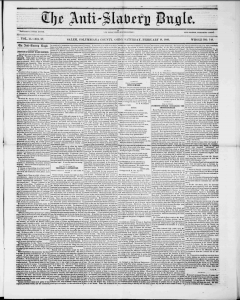
The first page of The Anti-Slavery Bugle, February 18, 1980.
One example of Lott’s argument comes from a little article that appeared in a New-Lisbon, Ohio abolitionist paper, The Anti-Slavery Bugle, on February 18, 1860. The newspaper’s self-proclaimed role was to “sound the bugle-note of Freedom over the hills and through the valleys” and it therefore contained a mixture of news about the anti-slavery movement, opinion pieces, essays, and stories like this one.2 Perhaps unsurprisingly, the article bears the dramatic title “A Negro Minstrel Sold into Slavery” and recounts a trial that took place in Galveston, Texas.3 Both the events that unfold in the story and they way that they are described suggest that perhaps minstrelsy and its music could provide a means by which a black man might gain better opportunities in the Antebellum South.
Ultimately the story tells of an affidavit and the subsequent rulings pertaining to “a free negro” who came to town, “calling himself Joseph Vincent Suarez, and passing himself for a white man”. This plays into another point of Lott’s, the idea that many Americans did not really know whether the minstrels entertaining them were black or white. In fact, the article describes that for the trial to commence, multiple doctors were called upon verify that Suarez was, indeed, a person of color. Suarez was therefore able to effectively blur the color line because his race was not immediately apparent.
Additionally, it is probably a fair assumption to say that Suarez’s minstrel act afforded him a better opportunity than would have otherwise been available. Suarez was able to capitalize on a popular form of music at the time and therefore advance himself economically and potentially socially.4
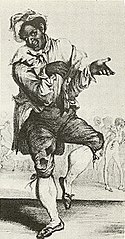
A caricature of a blackface minstrel performer around 1850-1860.
Furthermore, it is important to discuss Suarez’s punishment. While it is undoubtedly strict to modern readers, it is not as dramatic as the article’s headline makes it out to be and not as severe as what punishments could be for black men in the slave-holding South. Suarez was sentenced to be hired out for labor for six months, the profits from which were to go to his expenses during the time and then to his departure from Texas at the end of the term. What also bears consideration is the last line of the article: “It is proper to remark that this Suarez came to this city as a negro minstrel, and he has, therefore, the merit of passing himself off in his professional character for precisely what he is”. Again, Suarez’s minstrel profession furnishes him with benefits he might not otherwise gain. In this case, an excuse for a lower sentence.
Minstrelsy is certainly one of American history’s more embarrassing artifacts. But, as Lott discusses, perhaps even this very negative aspect of the popular culture provided some individuals with positive opportunities. If nothing else, like other forms of American music, minstrelsy helped in some places to blur the color line and throw into question the notion of separate racial cultures.
1Lott, Eric. Love and Theft: Blackface Minstrelsy and the American Working Class. Introduction and Chapter 1. New York: Oxford University Press, 1993.
2Harris, Glen Anthony. “Anti-Slavery Bugle.” In Encyclopedia of Emancipation and Abolition in the Transatlantic World, by Junius Rodriguez. Routledge, 2007. Accessed March 7, 2018. https://ezproxy.stolaf.edu/login?url=https://search.credoreference.com/content/entry/sharpeeman/anti_slavery_bugle/0?institutionId=4959.
3From the Galveston (Texas) News. “A NEGRO MINSTREL SOLD INTO SLAVERY.” The Anti-Slavery Bugle, Issue 27 (1860). Accessed March 7, 2018.
<http://find.galegroup.com/sas/infomark.do?&source=gale&prodId=SAS&userGroupName=mnastolaf&tabID=T003&docPage=article&searchType=&docId=GB2500047906&type=multipage&contentSet=LTO&version=1.0&relevancePageBatch=&docLevel=FASCIMILE>.
4Henderson, Clayton W. “Minstrelsy, American.” Grove Music Online. Accessed March 7, 2018. http://www.oxfordmusiconline.com/grovemusic/view/10.1093/gmo/9781561592630.001.0001/omo-9781561592630-e-0000018749.
Minstrelsy: Connecting Blackness to the Body and Whiteness to the Mind
White people putting on blackface and dressing up as black people for entertainment and comedic purposes is disturbing and upsetting on many levels. To me, an aspect of this that is particularly horrific is the effect it had on the body, particularly the black body, that is so often deemed invisible, expendable, dangerous, or hypersexual. Minstrelsy contributed to these stereotypes and beliefs about the black body by controlling how others perceived it. Minstrelsy allowed white people to take ownership over the black body by literally putting it on as a costume through blackface. They were then able to “prove” an amount of stereotypes through this, especially on account that many of the audience members did not know whether the people on stage were actually black or not.
Tying blackness to the body is something that has been done to justify colonialism as well as slavery. Much of this ties back to ideas that began to form during the Enlightenment. The Enlightenment marked the mind, reason, and individualism as core values; values that were used to distinguish between the “savage man” and “civilized man”. This was then used as reason to justify that the “savage” individual’s ideal role is physical labor, thus justifying slavery. The savage man was also believed to lack the intellect that the civilized man had. This idea was used justify the belief that people of differing races were of different species, and was also used to prove the need for savages to be “civilized” by Western/white society. These ideas reduced black people to merely a body, and deemed whites to be better because of their supposedly superior intellectual capabilities. It must be noted that this idea of connecting blackness to the body is deeply rooted in the belief that the body is sinful and dirty, as opposed to the purity of the mind. This is an idea which certainly can, and should, be questioned. But for the purpose of this blog post, it will be assumed that association with the body is going to be perceived by people as a negative thing.
Minstrelsy further emphasized this association of blackness with the body. This is particularly evident in this advertisement for a Minstrel Show in 1899. This ad depicts black women as hyper-sexualized and alludes to the “Jezebel” stereotype, an idea rooted in slavery which labels black women as promiscuous and sexually aggressive. Referring to a black woman as a jezebel has often been used to blame the infidelity of white men on the black women they had relations with. This hyper-sexualization further associates black people to the body, and implies an inability to control bodily instincts. The men depicted in the advertisement also emphasizes the association of blackness with the body as opposed to the mind. This is done through their childlike reaction to the woman in the advertisement. Their facial expressions mimic childlike amusement with the female body, while simultaneously depicting black men as out of control of their sexual desires. By connecting blackness with sexualization and desire, it again implies that black people are not capable of putting mind over matter, thus emphasizing the dichotomy of whiteness as associated with the mind, and blackness with the body.
Between the use of blackface, contributing to stereotypes, mockery, and misrepresentation of black culture, minstrel performances clearly have a a lot of racist elements within them. That being said, there are nuances to it. After all, it did allow black performers to have their first opportunity to perform in front of a white audience, and it could be argued that it helped popularize a variety of black music including spirituals. However even with these nuances, most aspects within minstrelsy perpetuated racism, sometimes in ways that are not as explicit as blackface, specifically strengthening the association of blackness with the body. Through this, minstrelsy reasserted this underlying justification behind treating black people as lesser that dates back to slavery and colonial times.
Sources:
- “Gideon’s Big Minstrel Carnival Advertisement.” In The American Mosaic: The African American Experience, ABC-CLIO, 2018. Image. https://africanamerican2.abc-clio.com/Search/Display/1612309.
- Marisa J. Fuentes, “Jezebel.” In The American Mosaic: The African American Experience, ABC-CLIO, 2018. https://africanamerican2.abc-clio.com/Search/Display/1750376.
- “Minstrel Music with African American Jim Crow Caricatures.” In The American Mosaic: The African American Experience, ABC-CLIO, 2018. https://africanamerican2.abc-clio.com/Search/Display/1612304.
- Peter A. Schrom, “The Enlightenment and the Origins of Racism” State University of New York at Albany, ProQuest Dissertations Publishing, 2016.
Performing Jim Crow: Stereotyping a People
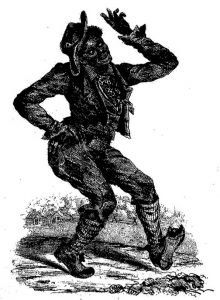
Williams Clay, Edward. “Mr. T. Rice as the Original Jim Crow”. In Jump Jim Crow: Lost Plays, Lyrics, and Street Prose of the First Atlantic Popular Culture by W. T. Lhamon, Jr. (Cambridge, Massachusetts: Harvard University Press, 2003).
In 1828 a New York City native, Thomas Rice, created the character of Jim Crow while performing in Louisville Kentucky. Performing in blackface, Rice presented the character of Jim Crow as a ragged, lazy, child-like, and irresponsible black man. Rice’s performance turned him into a celebrity, igniting the popularity of blackface minstrelsy throughout the United States.1
Blackface minstrelsy perpetuated and exaggerated stereotypes of blacks and thus served as a means of justifying slavery. Jim Crow was no exception. Jim Crow or the Sambo character quickly became the stereotype of black men. Depicted as ignorant, lazy, childish, and completely dependent on their master, minstrel performers justified slavery by implying that blacks were incapable of taking care of themselves. Spectators preferred this depiction of black men as loyal to their masters rather than the alternative stereotype of the Savage who was rebellious and would attack white women.2
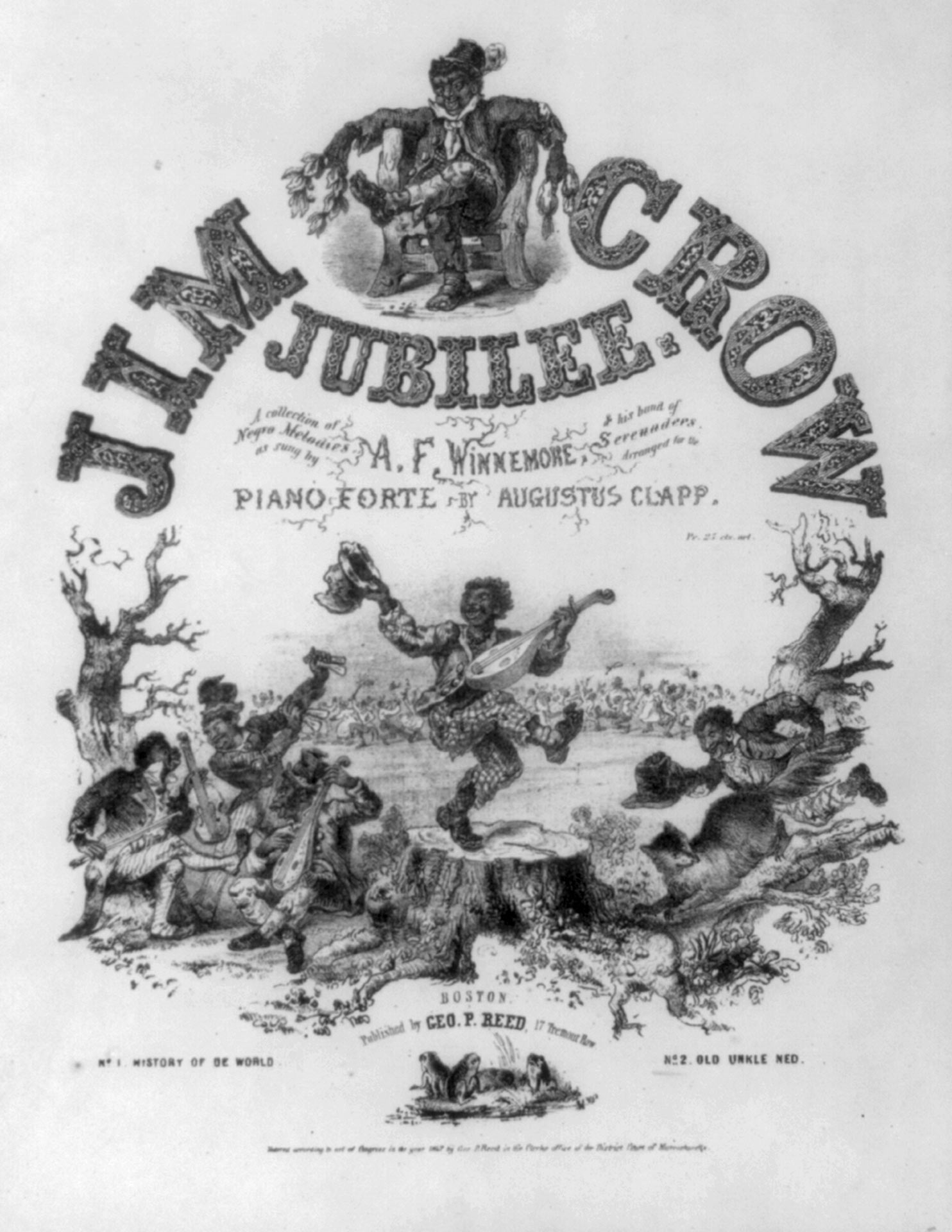
“Minstrel Music with African American Jim Crow Caricatures.” In The American Mosaic: The African American Experience, ABC-CLIO, 2018. Image. Accessed March 6, 2018. https://africanamerican2.abc-clio.com/Search/Display/1612304.
Published in 1847, the cover of the Jim Crow Jubilee sheet music, “a collection of Negro melodies” promotes the Jim Crow caricature and blackface minstrelsy. The cover mirrors the staging of a minstrel show: one central figure surrounded by three other performers with a fiddle, mandolin, and bones. The crowd of people in the background also suggests that this image is set on a plantation and that this characterization of black people’s appearance and behavior is representative of the black population.
The central figure of Jim Crow greatly resembles the original image of Jim Crow that advertised for Rice’s performances. Both feature a smiling black man with exaggerated and comical facial features and ragged clothing, including torn pants and shoes. While we discussed in class that performers often wore fantastical clothing on stage, the earlier characterizations of Jim Crow highlighted this disheveled appearance. In both images, the Jim Crows also strike a similar pose as if they are in the middle of dancing to the blackface minstrel music.
The origins of Jim Crow in black face minstrelsy highlight how a character’s name came to be a symbol of black people as a whole, discrimination, and institutional segregation across the South. Depictions of Jim Crow and other black characters demonstrated to audience members that blacks were inferior to whites in their appearance, speech, intellect, and general behavior and personality. This characterization reaffirmed color boundaries and led to the establishment of Jim Crow segregation laws.
1 Burns, James. “Thomas Rice.” In The American Mosaic: The African American Experience, ABC-CLIO, 2018. Accessed March 6, 2018. https://africanamerican2.abc-clio.com/Sear ch/Display/1606088.
2 Nuruddin, Yusuf. “Jim Crow Racial Stereotypes.” In The American Mosaic: The African American Experience, ABC-CLIO, 2018. Accessed March 6, 2018. https://africaname ri can2.abc-clio.com/Search/Display/1407153.
The Catchy Past: Separating the Song from the History
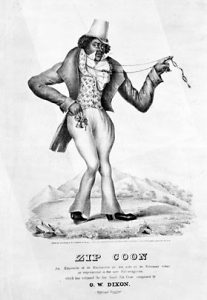
“Zip Coon.” In The American Mosaic: The African American Experience, ABC-CLIO, 2018. Image. Accessed March 7, 2018. https://africanamerican2.abc-clio.com/Search/Display/1612306.
Most children grow up learning songs by Stephen Collins Foster, and the melodies are quite catchy. However, if one thinks of the background of such tunes, and how they are mostly minstrel songs, they can seem problematic. Minstrel shows incorporated blackface: when white people would use burnt cork to give themselves the appearance of an African American with exaggerated features.1 While in this getup, they would portray racial stereotypes that are very offensive. This sheet music cover depicts one of the stock characters white men would portray in their minstrel performances.
The songs of minstrel shows inspired Stephen Foster into writing more of these popular tunes.2 He is famous for many memorable melodies, including “Oh, Susanna!” and “Old Folks at Home”. These songs remained popular well passed the 1920s, and we all know them today. If one watches a scene from Riding High (Frank Capra, 1950), one can hear the legendary Bing Crosby singing one of Foster’s hits, “Camptown Races”.
It sure is catchy! However, if one listens closely and reads the original lyrics, one can see where this song becomes problematic. First of all, the actual title is “De Camptown Races”, and the words are written in a way that portrays the dialect of a stereotypically, ill-educated, African American; for example: the use of “de” and “gwine”. This little ditty was originally written with the intention of white performers painting their faces black and singing the song in order to mock African Americans.3 Despite the racist nature of this tune, it lives on as an American folk classic, as many of Foster’s songs have.
I’m not saying it’s horrible to enjoy this song or others like it. Many people do. No matter if people still find the melody catchy today, it is important to remember the history, whether or not they associate the song with the disturbing truth of the past.
1 “Minstrel Songs – The Library of Congress Celebrates the Songs of America.” The Library of Congress. www.loc.gov/collections/songs-of-america/articles-and-essays/musical-styles/popular-songs-of-the-day/minstrel-songs/.
2 “Stephen Collins Foster, 1826-1864.” The Library of Congress. www.loc.gov/item/ihas.200035701/.
3 Ruehl, Kim. “The ‘Doo Dah’ Song: ‘Camptown Races’ by Stephen Foster.” ThoughtCo. October 25, 2017. www.thoughtco.com/camptown-races-stephen-foster-1322494.
William Henry Lane “Master Juba”
William Henry Lane, know as “Master Juba” on stage, was the most renowned black stage performer prior to the 1850’s. William performed with minstrel shows (Ethiopian Serenaders) and toured not only in the U.S. but to Europe. He was the first African American to perform in England. He was a famous performer and is arguably a main attributer and constituent to what we now call tap dance.
From Eric Lott’s Love and Theft: Blackface Minstrelsy and the American Working Class we know that African Americans dressing up and putting cork on their faces was a known thing, but Lane had done this in a time that was a prequel to thus. Lane had seemingly found success in the minstrel circuit.
Lane was a huge success over in England and the rest of Europe. An English critic after seeing Lane perform said:
Juba’s whirlwind style [was] executed with ease and “natural grace.” “[Such] mobility of muscles, such flexibility of joints, such boundings, such slidings, such gyrations, such toes and heelings, such backwardings and forwardings, such posturings, such firmness of foot, such elasticity of tendon, such mutation of movement, such vigor, such variety . . . such powers of endurance, such potency of ankle. (Conway)
Many viewers had a difficult time describing Lane’s style of dancing. It was upbeat and followed closely to the percussion of the music. It is argued whether the inability of others to describe his dancing style was do to his African background and whether he brought pieces of African dance into his style or not. Regardless, Lane became a sensation.
Lane and his style of dancing was so renowned that he had been mentioned in the works of Charles Dickens. He lived a hectic and short life, “records indicate Master Juba lived the intense life of a touring performer, giving shows every night. He also opened a dance school in London” (Peters). Unfortunately, Lane passed away in his late 20s in England.
Works Cited:
Lott, Eric. Love and theft: blackface minstrelsy and the American working class. Oxford University Press, 2013.

